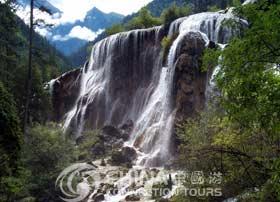 Nine Villages Valley China (Jiuzhaigou) is one of the earliest world heritage sites in China listed by UNESCO in 1990 s. It is located at an elevation of about 9,842.5 feet in the south of Min Mountain Range, about 279 miles south to this scenic nature reserve.
Nine Villages Valley China (Jiuzhaigou) is one of the earliest world heritage sites in China listed by UNESCO in 1990 s. It is located at an elevation of about 9,842.5 feet in the south of Min Mountain Range, about 279 miles south to this scenic nature reserve.
Nine Villages Valley is well known both at home and abroad for its natural scenery which includes snowy peaks, double waterfalls, colorful forests and green sea. Tibetan customs are another attraction. The essence of Nine Villages Valley, known as "king of Chinese water scenes", lies in its waters: lakes, spring waters, streams, waterfalls, rivers and shoals. As the saying describes "when coming back from the Huangshan Mountains one does not want to see a mountain; when coming back from Nine Villages Valley China one does not want to see water." There are six major scenic spots: Changhai, Jianyan, Nuorilang, Shuzheng, Zharu and Heihai. Mountains around the lakes ragging 1,980 to about 3,100 meters in height are covered by a variety of trees and plants such as green conifers, luxuriant broadleaf trees and colorful rare flowers and grasses. The mountains, lakes, natural primeval forest and unique scenes make Jiuzhaigou a fairyland. Scenes change according to the season. In the middle of the spring, the green and the flowers are beautiful. In summer the lakes are tranquil and mountains are azure. In golden autumn the trees are full of red leaves and in middle winter the glacial cascades are in thousands. Waterfalls, lakes, springs, rivers and shoals add to the color and the green trees, red leaves, snowy peaks and blue skies expression of Tibetan nationality as well as the animal and vegetation resources being richly endowed by nature are greatly favored by people. Nine Villages Valley China has been honored as the "World of Divine Tales Fairy Land on the earth ".
